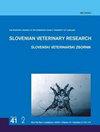HISTAMINE LEVEL AND HISTAMINE-PRODUCING BACTERIA ISOLATED FROM SALTED AND FREEZE SARDINE FISH (Sardina spp.)
IF 0.6
4区 农林科学
Q4 VETERINARY SCIENCES
引用次数: 0
Abstract
Histamine is the biogenic amine responsible for scombroid poisoning in various types of fish and fish products. The study evaluated histamine content and bacteriological quality of salted and freeze sardine samples. All fish samples were cultured on Reinforced Closterdial medium; mannitol salt (MS) agar and violet red bile glucose (VRBG) agar, the positive colonies were sub-cultured on histamine-forming bacterium agar, followed by biochemical and PCR identification. Production of histamine in the fish muscles was measured by high performance liquid chromatography. The mean histamine values were about; 8.25 mg/100g. The mean of total aerobic counts was; 4×104 ± 2.1×104 while, the total anaerobic count; 5×104 ±1.2×103 Log CFU/g. Enterobacteriacea spp. about; 5×104 ±2.5×104 Log CFU/g while, the mean value of Staphylococcus spp. about; 3×104 ±3.7×104 Log CFU/g. The mean value of histamine-forming bacterial were; 3.3×106 Log CFU/g. Molecular Identification For Enterobacteriaceae were Klebsiella pneumonia, Staphylococcus xylosus, Escherichia coli and Enterobacter cloacae. We concluded that during storage, there was a positive relationship between the histamine levels and the histamine-forming bacteria (HFB) numbers, while, histamine and the bacteria forming histamine were recorded in all examined sardine samples. Key words: histamine; Escherichia coli; Klebsiella pneumonia; molecular identification; scombroid; Staphylococcus xylosus盐渍和冷冻沙丁鱼组胺水平及产组胺细菌的分离
组胺是一种生物胺,可导致各种鱼类和鱼类产品中的鲭鱼中毒。本研究评价了腌制和冷冻沙丁鱼样品的组胺含量和细菌学质量。所有鱼样均在强化Closterdial培养基上培养;甘露醇盐(MS)琼脂和紫红胆糖(VRBG)琼脂,将阳性菌落传代于组胺形成菌琼脂上,进行生化和PCR鉴定。用高效液相色谱法测定鱼肌肉中组胺的产生。平均组胺值约为;8.25毫克/ 100克。总需氧计数平均值为;4×104±2.1×104,总厌氧计数;5×104±1.2×103 Log CFU/g。肠杆菌科约;5×104±2.5×104 Log CFU/g,葡萄球菌平均值约;3×104±3.7×104 Log CFU/g。组胺生成细菌的平均值为;3.3×106 Log CFU/g。肠杆菌科的分子鉴定为肺炎克雷伯菌、木糖葡萄球菌、大肠杆菌和阴沟肠杆菌。结果表明,在贮藏过程中,组胺含量与组胺形成细菌(HFB)数量呈正相关,而组胺含量与组胺形成细菌数量均有记录。关键词:组胺;大肠杆菌;克雷伯氏菌肺炎;分子识别;鲭亚目的;葡萄球菌xylosus
本文章由计算机程序翻译,如有差异,请以英文原文为准。
求助全文
约1分钟内获得全文
求助全文
来源期刊

Slovenian Veterinary Research
VETERINARY SCIENCES-
CiteScore
0.60
自引率
0.00%
发文量
12
审稿时长
>12 weeks
期刊介绍:
SLOVENIAN VETERINARY RESEARCH (ISSN 1580-4003) publishes original articles, which report the results of original research in most areas of biomedicine. The journal also publishes review articles dealing with rapidly developing areas of biomedicine or which update understanding of classical fields of biomedicine, as well as case reports, shorter scientific contributions, letters to the editor, etc.; which have not been published or are under consideration for publication elsewhere. Only papers written in English can be considered.
 求助内容:
求助内容: 应助结果提醒方式:
应助结果提醒方式:


